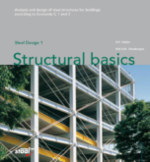Publicaties
prijs: normaal € 72,00 bedrijfsleden BmS: € 64,50
Structural basics is effective as a textbook for students and as a reference guide to the Eurocodes 0, 1 and 3 for practising structural engineers. It covers the design and analysis of steel structures for buildings according to EN 1990 (Eurocode 0), EN 1991 (Eurocode 1) and EN 1993 (Eurocode 3). Structural basics was originally published in 2011 (and updated in 2012) in Dutch as Krachtswerking. The text is based on the (English) EN version of the Eurocodes using default and/or recommended values. Where a country can make a national choice – or when non-contradictory complementary information may be used – this is indicated by a symbol (black square). Separate annexes contain (for now) the national choices for The Netherlands and Switzerland.
• Chapter 1 describes the theory and background of EN 1990 in terms of structural safety, reliability and the design values of resistances and actions.
• Chapter 2 deals with actions and deformations described in EN 1991. The permanent loads and variable actions and in particular the imposed loads and the snow and wind actions are discussed. This chapter also contains three worked examples to determine the actions on a floor in a residential house, the actions on a free-standing platform canopy at a station and the wind actions on the façades of an office building.
• Chapter 3 is about modeling, discussing the schematization of the structural system, the joints and the materials properties as well as the cross-section properties.
• Chapter 4 deals with the classification of frames and the various analysis methods for unbraced and braced frames.
• Chapter 5 then goes deeper into these analysis methods to determine the force distribution and deformations.
• Chapter 6 deals with the assessment by code-checking of (parts of) the steel structure with EN 1993-1-1 and EN 1993-1-8. At a basic level, the assessment of the resistance of cross-sections, the stability of members under axial forces and the resistance of bolted and welded connections are explained.
• Chapter 7 discusses in an extensive way the assessment by code-checking of the resistance of cross-sections, both for single and combined internal forces. The principles of the assessment of the resistance of cross-sections according to the elastic and plastic theory are also discussed.


